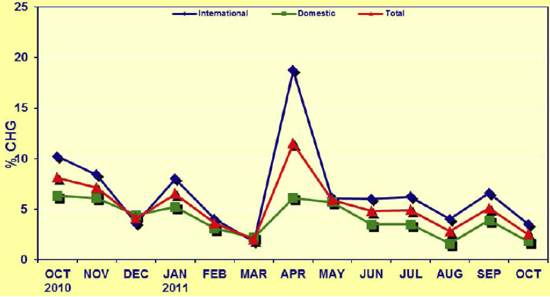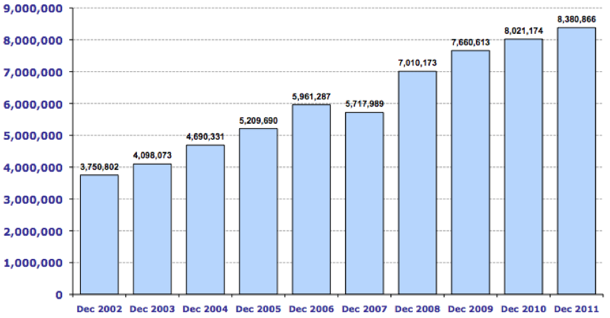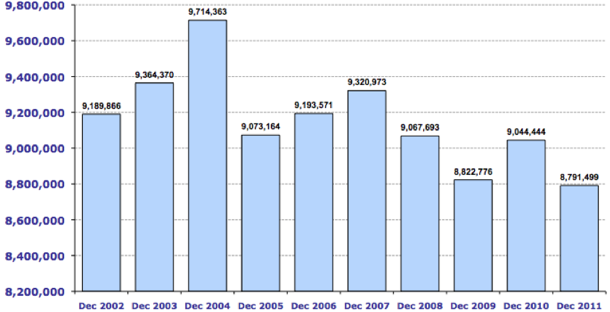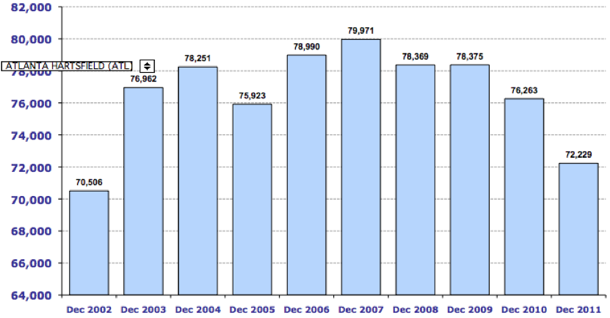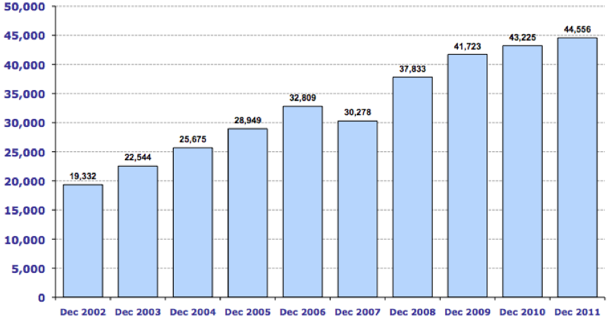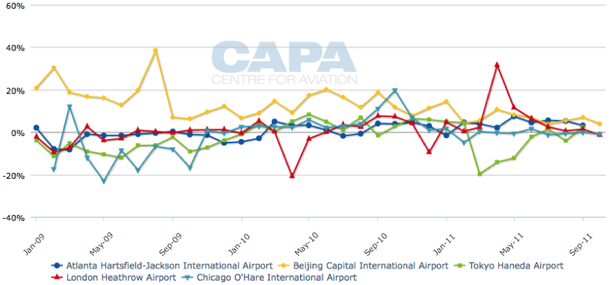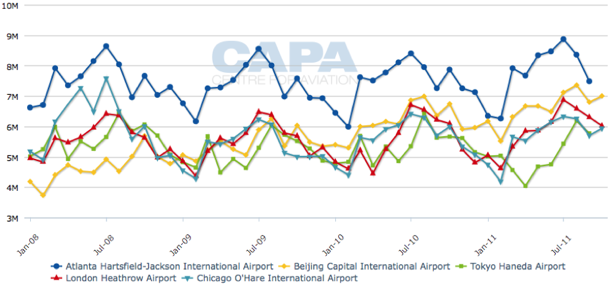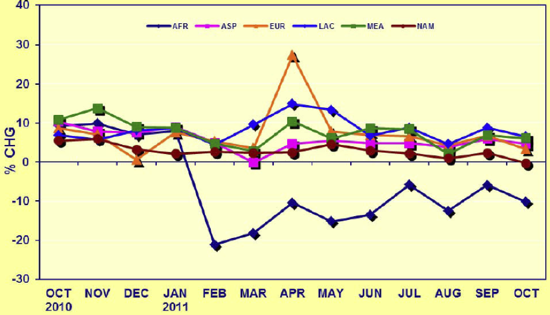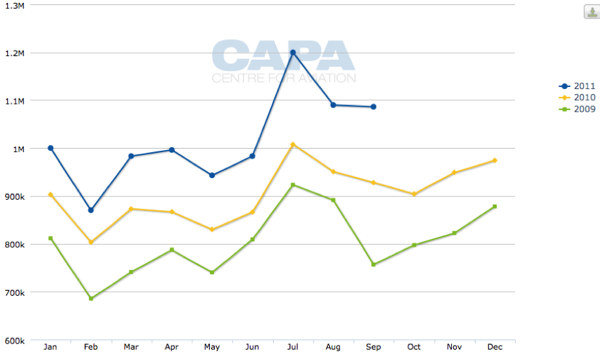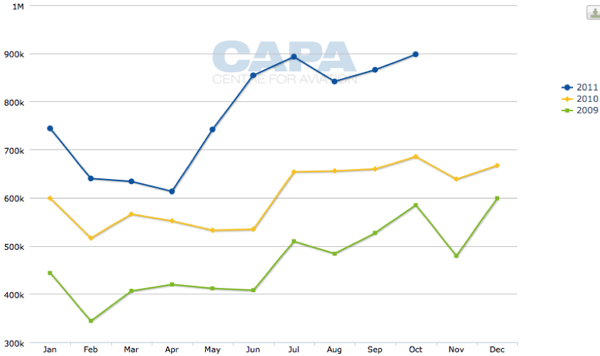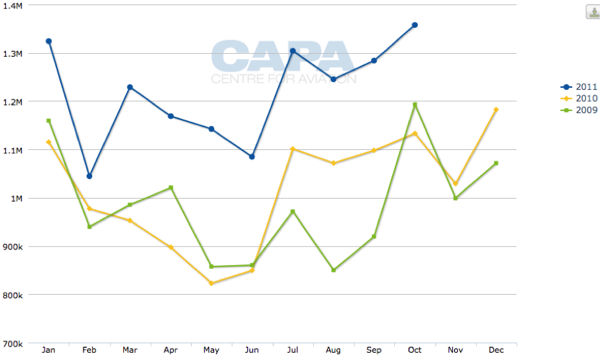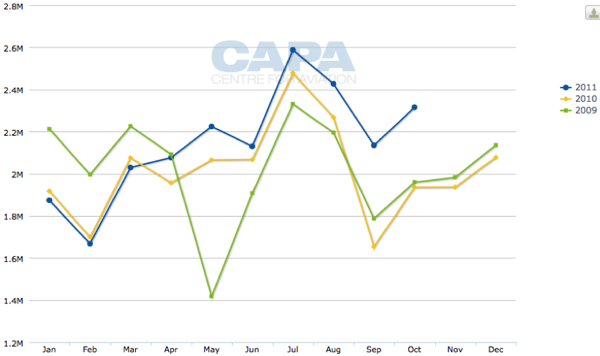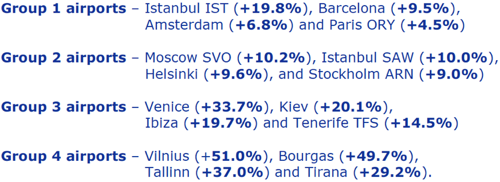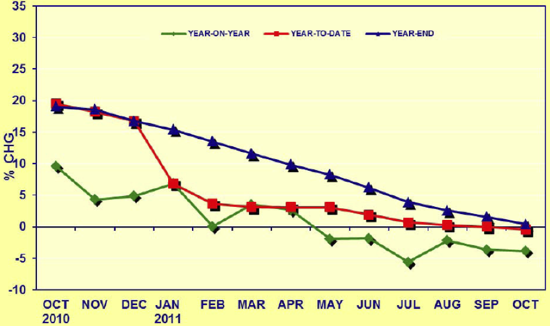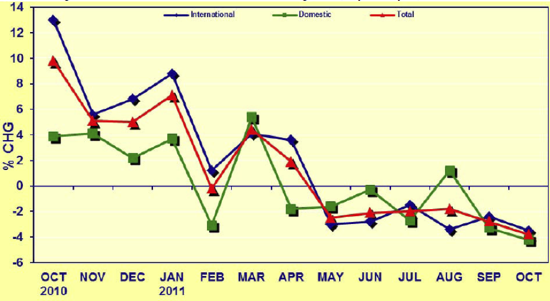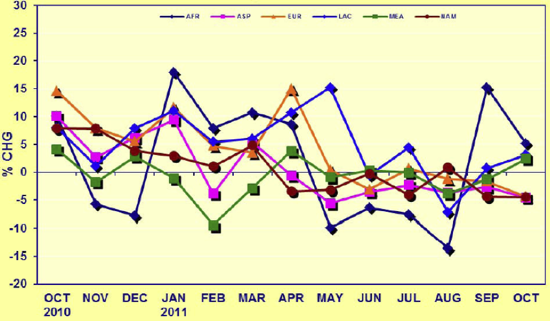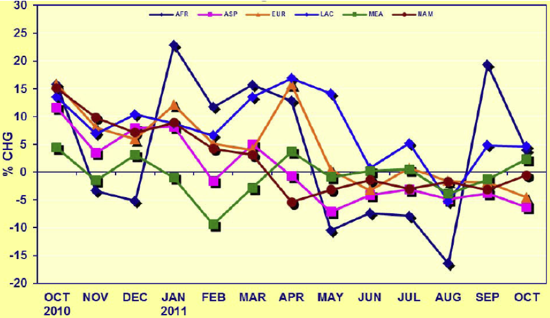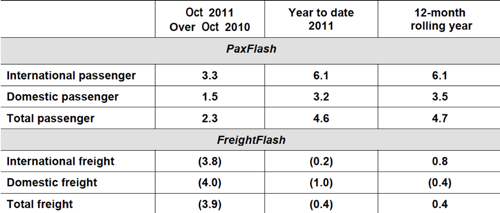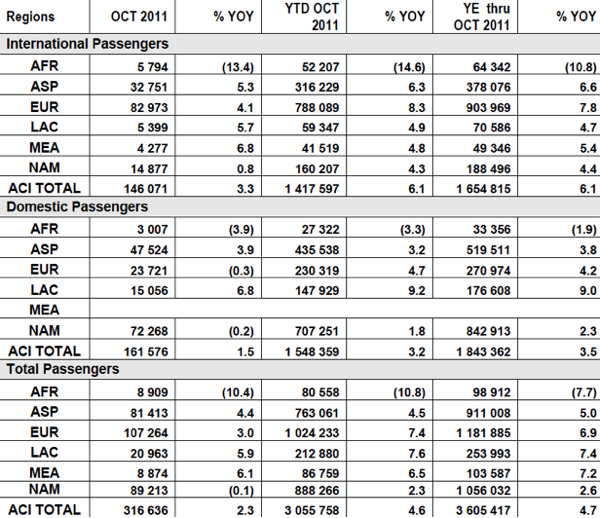Beijing narrows gap with Atlanta as world's busiest airport while Haneda overtakes Heathrow as #3
The world's busiest airport by total passenger movements, Atlanta Hartsfield-Jackson International Airport, continues to hold off Beijing, the world's second busiest airport, but it is only a matter of time before Atlanta is dethroned. Only a decade ago, Beijing Capital did not even rate among the world's top 30 airports, a list that Atlanta has headed since 1998. Beijing only appeared as one of the world's 30 largest airports in 2004, in 20th position, with passenger growth of over 43% in this year. This week Tokyo Haneda surpassed London Heathrow as the world's third largest airport.
Meanwhile, Airports Council International (ACI) in its Oct-2011 traffic release noted that passenger growth remains in resilient and positive territory despite the challenges in global markets. "The looming risks in major currency markets and economies have not yet affected consumption patterns for air travel," ACI World's economics director Rafael Echevarne commented.
In Oct-2011, global passenger traffic increased by 2.3%, with growth of 3.3% in international markets and 1.5% on domestic sectors. On a year-to-date basis, passenger traffic has increased by 4.6%, with a 3.2% increase in domestic and a 6.1% strengthening in international markets.
ACI World passenger trends: international, domestic and total traffic growth (%, year-on-year)
Atlanta sees capacity and frequency declines in Dec-2011; growth at Beijing
Atlanta saw a 5.3% decline in schedule frequency and 2.8% decline in seat capacity in Dec-2011, according to OAG FACTS data. Beijing, meanwhile, reported a 3.1% increase in frequency and 4.5% seat capacity growth in the month. At present, Atlanta has around 94,000 more weekly seats, or 410,000 monthly seats (Dec-2011) than its Chinese counterpart (equating to a 5% difference in seats), despite Beijing Capital reporting stronger year-on-year growth rates in recent months. Atlanta is also operating around 62% more frequencies in Dec-2011 than Beijing.
Beijing International Airport capacity (seats) trends: Dec-2002 to Dec-2011
Atlanta Hartsfield-Jackson International Airport capacity (seats) trends: Dec-2002 to Dec-2011
Atlanta Hartsfield-Jackson International Airport frequency trends: Dec-2002 to Dec-2011
Beijing International Airport frequency trends: Dec-2002 to Dec-2011
While an examination of capacity and frequency trends over the past decade highlight a stable upwards trend for Beijing and a weakening trend for Atlanta, Atlanta will still end the year as the world's largest airport, for the 14th consecutive year.
Traffic growth comparison (year-on-year change, %) for Atlanta Hartsfield-Jackson International Airport, Beijing Capital International Airport, Tokyo Haneda Airport, London Heathrow Airport, Chicago O'Hare International Airport:
Jan-2008 to Nov-2011
Traffic number (mill) comparison for Atlanta Hartsfield-Jackson International Airport, Beijing Capital International Airport, Tokyo Haneda Airport, London Heathrow Airport, Chicago O'Hare International Airport: Jan-2008 to Nov-2011
Tokyo Haneda overtakes London Heathrow
London Heathrow, the world's third largest airport, is also facing competition from an Asian counterpart, with Tokyo Haneda operating more capacity (seats) than London Heathrow in the week ended 11-Dec-2011.
Top 15 airports by capacity (seats): 05-Dec-2011 to 11-Dec-2011
|
Rank |
Airport |
Total seats |
|---|---|---|
|
1 |
2,014,720 |
|
|
2 |
1,920,985 |
|
|
3 |
1,740,966 |
|
|
4 |
1,725,780 |
|
|
5 |
1,453,564 |
|
|
6 |
1,439,494 |
|
|
7 |
1,421,571 |
|
|
8 |
1,385,356 |
|
|
9 |
1,372,452 |
|
|
10 |
1,364,755 |
|
|
11 |
1,295,559 |
|
|
12 |
1,290,904 |
|
|
13 |
Bangkok Suvarnabhumi International |
1,279,879 |
|
14 |
1,161,899 |
|
|
15 |
1,149,088 |
Resilient growth rates seen in the Middle East, Latin America/Caribbean and Asia Pacific
During Oct-2011, airport growth was driven by resilient growth rates in the Middle East (+6.1%), Latin America/Caribbean (+5.9%) and Asia Pacific (+4.4%), according to ACI.
ACI World total passenger regional trends: month-on-month comparison with the same month of the previous year
ACI World international passenger regional trends: month-on-month comparison with the same month of the previous year
Middle East
ACI noted that in the Middle East, Abu Dhabi continued to be among the high growth airports in the region at 17.2%. Abu Dhabi Airports Company (ADAC), in late Nov-2011, stated it expects traffic to exceed 12 million passengers in 2011, with a year-on-year increase of 11% from 2010 levels. ADAC is forecasting double-digit growth for the next few years. Passenger traffic for the first nine months of the year rose 9% year-on-year, to 9 million.
Abu Dhabi International Airport passenger development (mill): 2009 to 2011
Latin America
While international traffic remains strong for many airports in Latin America and the Caribbean, domestic markets in Brazil and Mexico are continued sources of growth for the region. Airports such as Belo Horizonte, Rio de Janeiro and Mexico City experienced gains of +29.2%, +20.1% and +19.6%, respectively, ACI said.
Belo Horizonte Tancredo Neves International Airport passenger development (mill): 2009 to 2011
Rio De Janeiro-Galeão International Airport passenger development (mill): 2009 to 2011
Mexico City Juarez International Airport passenger development (mill): 2009 to 2011
Asia-Pacific
In the Asia Pacific region, New Delhi, the largest airport in India, and Jakarta, the largest Indonesian airport, have witnessed strong growth rates, of 33.3% and 17.9%, respectively, in domestic traffic. During Nov-2011 and based on OAG FACTS data, Southeast Asia key hubs commanded four of the top 10 rankings by incremental numbers of seats, represented by Jakarta, Manila, Singapore Changi and Kuala Lumpur. Including Delhi and Hong Kong, the incremental 2.995 million seats in these six airports is a strong testimonial that the Asia Pacific is the main driver of aviation growth, OAG noted.
Significant downturn in Europe but with some strong growth
Europe saw more moderate growth, fuelled primarily by international travel. ACI Europe, in a separate release, stated that "following several months of significant disparity between trends in passenger and freight traffic, the October figures of airport traffic in Europe reveal a significant slowdown in European passenger traffic growth".
The overall passenger traffic at European airports increased by 3.4% in Oct-2011, half the growth rate seen in Sep-2011. Overall aircraft movements increased 1.3%, lowered by the continued entrenchment of negative freight growth (-4.9% in Oct-2011).
Among Europe's largest airports handling more than 25 million annual passengers ('Group 1'), there was a 3.1% increase in passengers in the month. Growth was also seen at the region's smaller airports: 'Group 2' airports (airports handling between 10 and 25 million passengers) witnessed growth of 2.7%. 'Group 3' airports (five to 10 million passengers) expanded by 5.1% while 'Group 4' (<5 million annual passengers) was weaker at 4.0%. The same comparison of Oct-2011 with Oct-2009 levels shows average increases of +10.8%, +13.6%, +16.9% and +4.0% respectively, across the four airport groups.
Among the Group 1 airports, Istanbul Ataturk reported double-digit passenger growth of 19.8% with Barcelona El Prat also seeing solid growth rates, as has been the trend of late. Other airports which saw rapid passenger growth in Oct-2011 included Vilnius (+51%), Bourgas (+49.7%), Tallin (+37%), Venice Maro Polo (+33.7%), Tirana (+29.2%) and Kiev (+20.1%) all with growth of above 20% in Oct-2011. (The figure for Venice may be inflated since the temporary closure of Venice Trevisio saw its traffic use Marco Polo.)
ACI Europe traffic results*: Oct-2011
Based on Nov-2011 capacity data, OAG FACTS noted that Tirana recorded the highest growth rate of 65%, followed by Tallinn (37%) in Europe (Mexico City was in between these two European airports with growth of 38%). Based on absolute numbers, Istanbul sustained its aggressive growth with an additional 917,315 seats. In terms of schedule frequency, Tirana Airport achieved the highest growth rate of 57% year-on-year (followed by Montevideo (50%) and Islamabad (45%)).
According to the CAPA Airport Rankings Tool, Istanbul Ataturk was the world's 21th largest airport in terms of system capacity (ASKs) in the week commencing 05-Dec-2011. Barcelona El Prat ranked 42nd. Europe's largest airport was London Heathrow (ranked fourth on a world wide basis), followed by Frankfurt (sixth), Paris CDG (seventh), Madrid Barajas (18th), Amsterdam Schiphol (20th) and Munich (25th) in the Top 25.
North America flat
North America saw generally flat growth in international (+0.8%) and domestic (-0.2%) passenger traffic, although higher growth will likely be experienced during the Nov-2011 and Dec-2011 holiday season. However, traffic over this peak period is expected to be weaker than in previous years, according to the Air Transport Association of America (ATA).
ATA forecasts around 23.2 million passengers will fly on US carriers' domestic and international routes during a 12-day period surrounding Thanksgiving (18-Nov-2011 to 29-Nov-2011), a 2% year-on-year reduction and equating to around 37,000 fewer people per day compared with last year, as US carriers have reduced capacity to match demand and offset higher costs. The 2011 expectations anticipate that total volumes for the period will be 12% less than the peak volumes reached in the same period in 2006.
Continued social and political unrest affects North Africa
With continued social and political unrest in North Africa, the region is experiencing a temporary shift in passenger traffic away from the region as a travel destination. Major Egyptian and Tunisian airports have witnessed double-digit declines, according to ACI. Cairo saw a decline of 25.9% while Tunis experienced a decline of 12.3%. However, some traffic appears to have been diverted to Enfidham, which has seen traffic rise by 205.7%, ACI noted.
According to OAG FACTS Nov-2011 capacity data, Tripoli suffered the largest year-on-year decline in seat capacity of 93%. Tripoli also recorded the highest decline in schedule frequency in Nov-2011.
Freight decline shows no relent
ACI, meanwhile, continues to voice its concerns about the health of the global air freight market, echoing comments made by IATA and an increasing number of airlines, that the industry is "likely to observe year over year declines in freight traffic over the months to come". With air freight "on the sidelines", passenger growth in Oct-2011 remained in resilient and positive territory despite the challenges in global markets.
Mr Echevarne commented: "Traffic in air freight, as a leading indicator, is much more sensitive to pending risks in the business cycle. International trade in air freight has been placed on the back burner until business confidence is revived, particularly with respect to the economies of Europe, Asia and North America. With the remaining fears of a possible Euro break-up, we are likely to observe year over year declines in freight traffic over the months to come."
Sixth consecutive month of year-on-year declines for freight
Air freight has now seen its sixth consecutive month of year over year decline up until Oct-2011, with a 3.9% weakening in freight volumes in the month. International and domestic markets have seen year-on-year reductions of 3.8% and 4.0%, respectively.
ACI World total freight trends: year-on-year, year-to-date and year-end comparison: Oct-2010 to Oct-2011
ACI World freight trends: international, domestic and total traffic growth (%, year-on-year)
Global exporters in Asia experienced sharp declines in total freight with Hong Kong (-8.2%), Shanghai (-9.8%) and Incheon (-8%) all witnessing freight contractions, according to ACI. The major North American freight airports all experienced declines in their year over year volume. Memphis saw a decline of 1.5% while both Anchorage and Louisville declined by over 5%. There was a similar situation in Europe, with a 4.4% year-on-year decline in freight. Among the major airports in the region, declines were observed in Frankfurt (-9.5%), Amsterdam (-3.8%) and London Heathrow (-7.2%).
ACI World regional total freight trends: month-on-month comparison with the same month of the previous year
ACI World regional international freight trends: month-on-month comparison with the same month of the previous year
Despite the overall slowdown in global air freight, certain trading blocks in Africa, Latin America and the Middle East are less affected by the risks associated with sovereign debt in developed economies. Contrary to Africa's decline in air passenger travel, air freight has posted the greatest gains compared to all other regions, although much of the region's growth can be attributed to Johannesburg, with a growth rate of 8% in the month. International freight in key Brazilian airports observed notable double-digit gains. São Paulo Guarulhos and Campinas saw gains 13.7% and 10.7%, respectively. The Middle East saw modest gains with overall growth reaching 2.3%.
Based on the weakening freight trends in the past few months and an overall slowdown in passenger traffic, it is expected that a downturn in passenger traffic, and also in the freight markets, is expected in the months ahead, reflecting the continued weakness in freight and economic markets and consumer confidence levels.
APPENDIX
ACI worldwide airport traffic growth (year-on-year change): Oct-2011
ACI passenger traffic summary: Oct-2011
ACI freight traffic summary: Oct-2011
